

Labours of Hercules. The twelve labours of Hercules or dodekathlon (Greek: δωδέκαθλον, dodekathlon) are a series of episodes concerning a penance carried out by Heracles, the greatest of the Greek heroes, whose name was later Romanised as Hercules.
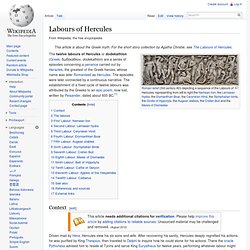
The episodes were later connected by a continuous narrative. The establishment of a fixed cycle of twelve labours was attributed by the Greeks to an epic poem, now lost, written by Peisander, dated about 600 BC.[1] Context[edit] Driven mad by Hera, Hercules slew his six sons and wife. After recovering his sanity, Hercules deeply regretted his actions; he was purified by King Thespius, then traveled to Delphi to inquire how he could atone for his actions. Eurystheus ordered Hercules to perform ten labours. Mares of Diomedes. The Eighth Labour of Heracles[edit] After capturing the Cretan bull, Heracles was to steal the Mares.
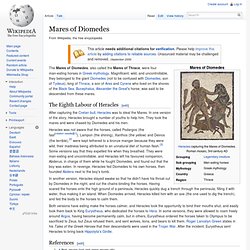
In one version of the story, Heracles brought a number of youths to help him. They took the mares and were chased by Diomedes and his men. Heracles was not aware that the horses, called Podargos (the fast[citation needed][1]), Lampon (the shining), Xanthos (the yellow) and Deinos (the terrible),[2] were kept tethered to a bronze manger because they were wild; their madness being attributed to an unnatural diet of human flesh.[3] Some versions say that they expelled fire when they breathed.
Stymphalian birds. In Greek mythology, the Stymphalian birds (Greek: Στυμφαλίδες ὄρνιθες, Stymphalídes órnithes) were man-eating birds with beaks of bronze and sharp metallic feathers they could launch at their victims, and were pets of Ares, the god of war.
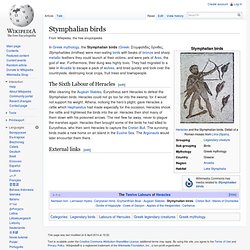
Furthermore, their dung was highly toxic. They had migrated to a lake in Arcadia to escape a pack of wolves, and bred quickly and took over the countryside, destroying local crops, fruit trees and townspeople. Hippolyta. In Greek mythology, Hippolyta, Hippoliyte, or Hippolyte (Ἱππολύτη) was the Amazonian queen who possessed a magical girdle she was given by her father Ares, the god of war.
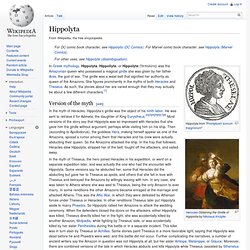
The girdle was a waist belt that signified her authority as queen of the Amazons. She figures prominently in the myths of both Heracles and Theseus. As such, the stories about her are varied enough that they may actually be about a few different characters.[1] Geryon. Geryon was often described as a monster with human faces.
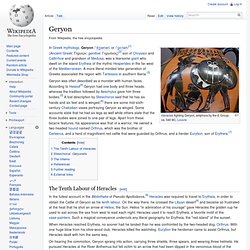
According to Hesiod[4] Geryon had one body and three heads, whereas the tradition followed by Aeschylus gave him three bodies.[5] A lost description by Stesichoros said that he has six hands and six feet and is winged;[6] there are some mid-sixth-century Chalcidian vases portraying Geryon as winged. Some accounts state that he had six legs as well while others state that the three bodies were joined to one pair of legs. Apart from these bizarre features, his appearance was that of a warrior.
Augeas. In Greek mythology, Augeas (or Augeias, /ɔːˈdʒiːəs/, Ancient Greek: Αὐγείας), whose name means "bright", was king of Elis and father of Epicaste.
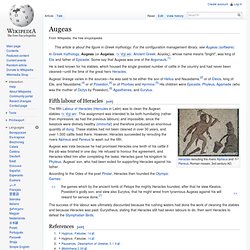
Cerberus. Cerberus /ˈsɜrbərəs/,[1] or Kerberos, (Greek form: Κέρβερος, [ˈkerberos])[2] in Greek and Roman mythology, is a multi-headed (usually three-headed) dog, or "hellhound" [1][3][4] with a serpent's tail, a mane of snakes, and a lion's claws.[5] He guards the entrance of the underworld to prevent the dead from escaping and the living from entering.
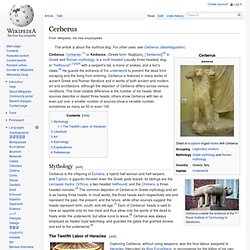
Cerberus is featured in many works of ancient Greek and Roman literature and in works of both ancient and modern art and architecture, although the depiction of Cerberus differs across various renditions. The most notable difference is the number of his heads: Most sources describe or depict three heads; others show Cerberus with two or even just one; a smaller number of sources show a variable number, sometimes as many as 50 or even 100. Erymanthian Boar. Hesperides. Nemean lion. The Nemean[pronunciation?]
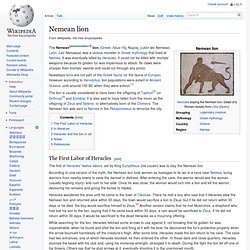
Lion (Greek: Λέων τῆς Νεμέας (Léōn tēs Neméas); Latin: Leo Nemaeus) was a vicious monster in Greek mythology that lived at Nemea. It was eventually killed by Heracles. It could not be killed with mortals' weapons because its golden fur was impervious to attack. Its claws were sharper than mortals' swords and could cut through any armor.
Lernaean Hydra. The Second Labour of Heracles[edit] Eurystheus sent Heracles to slay the Hydra, which Hera had raised just to slay Heracles.
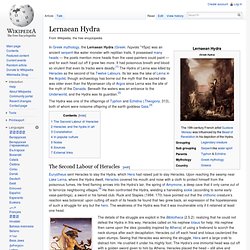
Upon reaching the swamp near Lake Lerna, where the Hydra dwelt, Heracles covered his mouth and nose with a cloth to protect himself from the poisonous fumes. He fired flaming arrows into the Hydra's lair, the spring of Amymone, a deep cave that it only came out of to terrorize neighboring villages.[4] He then confronted the Hydra, wielding a harvesting sickle (according to some early vase-paintings), a sword or his famed club.
Ruck and Staples (1994: 170) have pointed out that the chthonic creature's reaction was botanical: upon cutting off each of its heads he found that two grew back, an expression of the hopelessness of such a struggle for any but the hero. Cretan Bull. Origin[edit] The myth of Poseidon sending the bull (which seduced Minos' wife) may simply be an earlier version of the myth of Zeus seducing Europa, as in earlier Mycenean times, Poseidon had significantly more importance than Zeus.
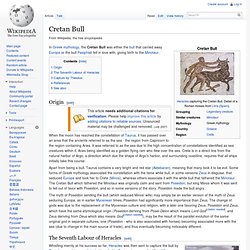
The change of gods was due to the replacement of the Mycenean culture and religion, with a later one favoring Zeus. Ceryneian Hind. In Greek mythology, the Ceryneian Hind (Greek: Κερυνίτιδα Έλαφος), also called Cerynitis or the Golden Hind, was an enormous hind (deer), who lived in Keryneia, Greece. It was sacred to Artemis, the chaste goddess of the hunt, animals and unmarried women. It had golden antlers like a stag and hooves of bronze or brass, and it was said that it could outrun an arrow in flight.